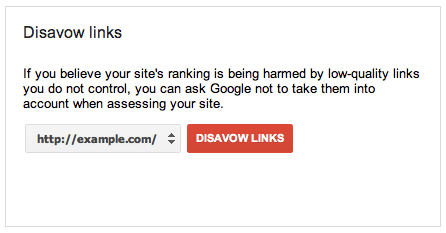Google Release ‘Disavow Links’ Tool
Yesterday, Google unveiled a new tool that allows webmasters to disavow links via Google Webmaster Tools. This means that those who have been caught up in link spam and received a message from Google about unnatural links being detected can upload a text file list of links to ensure that those links are disregarded.

Google head of webspam Matt Cutts has made a video in which he gives some advice to anyone who might be thinking about using the tool:
“First and foremost, the main thing that we recommend is getting those (low quality/spammy) links removed from the web. We recommend you write to people, as many as you can, to get those links taken down. At the point where you have written to as many people as you can, multiple times, you've really tried hard to get in touch and you've only been able to get a certain fraction of links down and there's still a small fraction of links left, that is where you can use our disavow tool."
The key point made by Matt in the video is that webmasters should make considerable attempts to have links removed manually before thinking about using the disavow links tool.
Matt talks about ways in which the tool can be used, highlighting a method of looking at the most recent links for sites where an unnatural link warning message has only just been received.
Google are also reportedly working on ways to include examples of low quality and/or paid links within any warning messages that are sent to webmasters. Matt stated that up to three examples will be included in future warning messages.
How to use the disavow links tool:
The following steps were given by Matt as advice for anyone wishing to use the tool:
- Create a text file listing the URLs of individual links to disavow (one URL per line)
- Use the domain: parameter to disavow all links from a single domain e.g. domain:example.com
- Use hash symbols (#) to indicate comments. This can be used to document previous attempts to have links removed or provide extra levels of context which will be read by Google’s webspam team
- Upload the text file to the tool via Google Webmaster Tools (one file per domain)
- Google has added a function which allows uploaded text files to be downloaded and edited if further linking URLs need to be added at any time.
How will Google treat this information?
Matt Cutts went on to give insight into how the information submitted via the tool will be treated by Google:
“We will treat it [disavow requests] as a very strong suggestion but not as something we absolutely have to abide by – basically we treat it as ’nofollow’ and will drop that link out of our processing”
An important point to note is the timescale in which the information will be processed:
"We do expect that it will take probably weeks once you upload your list of links to disavow for all of those links to be disavowed, because we have to recrawl, reindex and reprocess all of those pages in order to attach the attribute that says ”don't treat this link with the same weight, treat it with zero weight””
Key points
- Only use the disavow links tool if you have good reason to think that you need to
- If you are submitting reconsideration requests, explicitly mention that you have also submitted links to be disavowed (where applicable)
Matt talked about a hypothetical scenario in which a link that had been submitted via the tool and disavowed was then requested to be reavowed. He suggested that it would take a considerable amount of time for disavowed links to be reinstated, and that they may not carry the same weight as they once did.
At the end of the video, Matt reiterated that the disavow tool is an advanced one, and that most people (proportional to those on the web) will not need to use it. He compares the tool to the rel=”canonical” attribute, stating that if a canonical tag points to a non-existent place then you can “shoot yourself in the foot”. Similarly, he advises users to perform an audit of their backlinks and get an idea of the “truly spammy” links before uploading lists to the tool to avoid disavowing links which are not spammy.
You can watch the whole video below:
Further to the disavow link tool being released Christoph Cemper from Link Research Tools announced that their Link Detox tool has been integrated with the Disavow Links tool to allow users to get a one-click export of low quality links in the correct text file format.
You can find more information on the Link Detox tool integration here.